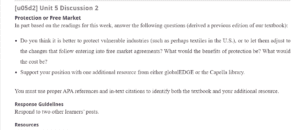Protecting Vulnerable Industries
Do you think it is better to protect vulnerable industries (such as perhaps textiles in the U.S.), or to let them adjust to the changes that follow entering into free market agreements? What would the benefits of protection be? What would the cost be?
I think it is important for the government to protect local industries. There are many factors that make it impossible for some local industries to compete successfully with similar industries in other countries (Barattieri et al., 2018). For example, the textile industry in the U.S. needs protection because it is hard for it to successfully compete with the much cheaper production costs in the textile industries of countries where the labor cost is significantly low. In some Asian countries, textile companies have access to extremely cheap production options, which cannot be compared to the costs in the U.S. When two companies from these two industries go into the market, one will have a significant cost advantage and the potential to kill the other.
The benefit of protection is safeguarding local industries against competition they cannot keep up with. By doing this, the government is helping to protect the local economies by protecting sources of revenue and keeping the unemployment rate low. However, the danger of overprotection of the local industries is that it keeps them from growing. When government-developed trade policies shield companies, they are likely to take advantage and fail to adjust to meet the new demands of the changing markets (Panchenko & Reznikova, 2017). Therefore, this can promote the stunted growth of local industries. This is why it is important for the government to allow some level of competition in the market. While there should be government control, the control should be limited to allow other international businesses to drive local competition and enable local industries’ growth.
References
Barattieri, A., Cacciatore, M., & Ghironi, F. (2018). Protectionism And The Business Cycle (No. w24353). National Bureau of Economic Research.
Panchenko, V., & Reznikova, N. (2017). From Protectionism to Neo-Protectionism: New Dimensions of Liberal Regulation. International Economic Policy, (27), 91-111.
ORDER A PLAGIARISM-FREE PAPER HERE
We’ll write everything from scratch
Question
[u05d2] Unit 5 Discussion 2
Protection or Free Market
In part based on the readings for this week, answer the following questions (derived a previous edition of our textbook):

Protecting Vulnerable Industries
- Do you think it is better to protect vulnerable industries (such as perhaps textiles in the U.S.), or to let them adjust to the changes that follow entering into free market agreements? What would the benefits of protection be? What would the cost be?
- Support your position with one additional resource from either globalEDGE or the Capella library.
You must use proper APA references and in-text citations to identify both the textbook and your additional resource.
Response Guidelines
Respond to two other learners’ posts.
Resources
- Discussion Participation Scoring Guide.
- . (Looking for DISTINGUISHED – set up your paper to hit each Topic)
UNDERGRADUATE DISCUSSION PARTICIPATION SCORING GUIDE
Due Date: End of weekly
Percentage of Course Grade: 30%.
| UNDERGRADUATE DISCUSSION PARTICIPATION GRADING RUBRIC | ||||
| Criteria | Non-performance | Basic | Proficient | Distinguished |
| Apply relevant course concepts, theories, or materials correctly. 33% |
Does not explain relevant course concepts, theories, or materials. | Explains relevant course concepts, theories, or materials. | Applies relevant course concepts, theories, or materials correctly. | Analyzes course concepts, theories, or materials correctly, using examples or supporting evidence. |
| Collaborate with fellow learners, relating the discussion to relevant course concepts. 33% |
Does not collaborate with fellow learners. | Collaborates with fellow learners without relating the discussion to the relevant course concepts. | Collaborates with fellow learners, relating the discussion to relevant course concepts. | Collaborates with fellow learners, relating the discussion to relevant course concepts and extending the dialogue. |
| Apply relevant professional, personal, or other real-world experiences. 34% |
Does not contribute professional, personal, or other real-world experiences. | Contributes professional, personal, or other real-world experiences, but contributions lack relevance. | Applies relevant professional, personal, or other real-world experiences. | Applies relevant professional, personal, or other real-world experiences to extend the dialogue. |
Participation Guidelines
Actively participate in discussions. To do this you should create a substantive post for each of the discussion topics. Each post should demonstrate your achievement of the participation criteria. In addition, you should respond to the posts of at least two of your fellow learners for each discussion question—unless the discussion instructions state otherwise. These responses to other learners should be substantive posts that contribute to the conversation by asking questions, respectfully debating positions, and presenting supporting information relevant to the topic. Also, respond to any follow-up questions the instructor directs to you in the discussion area.
To allow other learners time to respond, you are encouraged to post your initial responses in the discussion area by midweek. Comments to other learners’ posts are due by Sunday at 11:59 p.m. (Central time zone).


